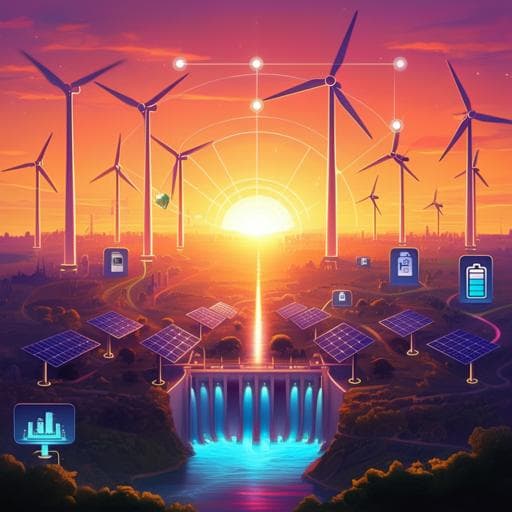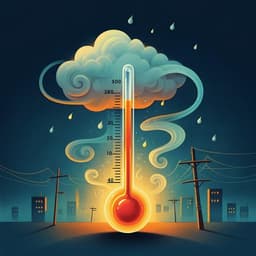
Engineering and Technology
The role of renewables for rapid transitioning of the power sector across states in India
A. Gulagi, M. Ram, et al.
This research, conducted by Ashish Gulagi, Manish Ram, Dmitrii Bogdanov, Sandeep Sarin, Theophilus Nii Odai Mensah, and Christian Breyer, reveals a compelling path for India's power sector towards a renewables-based system by 2050, which promises lower costs, zero emissions, and reliable electricity while supporting economic growth.
~3 min • Beginner • English
Introduction
The study is motivated by increasing extremity and abnormality of climate-related events and India’s vulnerability to climate change. India has committed to reduce the GHG emissions intensity of GDP and to expand non-fossil electricity capacity, including a target of 450 GW renewables by 2030. Despite near-universal electrification, per capita electricity consumption (about 1200 kWh in 2020) remains below the global average, with reliability and demand expected to grow. The power sector is India’s largest energy-related GHG emitter, heavily reliant on low-quality coal with air pollution, water stress, and economic challenges (low PLFs, uncompetitive costs vs. solar PV). Thermal plants also face significant freshwater constraints and risk of stranded assets. Meanwhile, renewable installations, especially solar and wind, have grown rapidly due to falling costs and supportive policies. State-level VRE penetration varies widely, necessitating coordinated national and state actions. Decarbonizing the power sector is crucial for broader energy system decarbonization via electrification. Prior studies often lack state-level resolution, hourly modeling, storage/flexibility detail, clear transition pathways, or consider limited RE shares. This work addresses those gaps to assess a cost-optimal, fully renewable transition for India’s power sector by 2050 at state resolution.
Literature Review
The paper reviews multiple long-term transition studies for India, noting common limitations: national-level focus without state granularity, insufficient temporal and spatial resolution, limited storage/flexibility representation, absence of detailed transition pathways, and constrained renewable penetration assumptions. While some studies (WWF/TERI, Teske et al., Jacobson et al., Lawrenz et al., Gulagi et al., Bogdanov et al.) consider 100% RE, they lack one or more of the above aspects. The study positions itself to provide high temporal resolution (hourly), spatial detail at the state level, comprehensive inclusion of storage and flexibility (batteries, gas storage, ICEs, grid), and an explicit pathway from the current to a fully renewable system by 2050.
Methodology
Model: The LUT Energy System Transition Model is applied to India’s power sector from 2015 to 2050, optimized in 5-year steps, with hourly resolution for a full year. A hierarchical approach models four regional grids (Northern, Western, Southern, Eastern+Northeastern) and then expands to 22 state/region nodes interconnected via HVDC/HVAC lines. Perfect foresight is assumed. Optimization uses MOSEK v8 (LP), compiled in Matlab. Objective: Minimize total annual system cost (annualized CAPEX with CRF, fixed/variable OPEX, ramping costs, fuel, grid expansion, and GHG emission costs), subject to hourly supply-demand balance in each state, storage dynamics and losses, and transmission constraints.
Key constraints and assumptions:
- No new coal, nuclear, or conventional oil-based power plants after 2015 (except units commissioned 2015–2019). Gas turbines and multi-fuel reciprocating ICEs permitted for flexibility and e-fuel use; legacy fossil capacity amortized and phased down, can sit in cold reserve.
- Annual growth in the share of installed RE capacity limited to max 4% of total installed capacity per annum from 2020 onward (empirically grounded).
- Hourly energy balance per state includes generation, imports, storage charge/discharge, exports, and curtailment with transmission/storage losses.
- Prosumer modeling (residential, commercial, industrial rooftop PV+batteries) is done exogenously per state segment to minimize end-user annual electricity cost (grid purchases minus feed-in revenues), producing adjusted net load for the centralized system.
Spatial configuration: 22 states/regions aggregated into 4 regional grids; Union Territories (except Delhi) combined with adjacent states; Northeastern states aggregated; Eastern and Northeastern grids combined for modeling.
Demand: Per capita electricity demand increases from 1.2 MWh (2020) to 3.5 MWh (2050); population ~1.7 billion in 2050. Total power sector demand reaches about 5921 TWh by 2050. Hourly load profiles synthesized for each state to 2050, accounting for seasonal/daily variations and prosumer self-supply.
Technologies: Generation includes utility PV (fixed tilt and single-axis tracking), rooftop PV, wind onshore/offshore, hydro (reservoir, run-of-river), CSP, geothermal, bioenergy (biomass, biogas, waste-to-energy), fossil (coal, oil, gas CCGT/OCGT), nuclear, and new flexible options (multi-fuel ICE, heavy-duty OCGT). Storage includes Li-ion batteries, PHES, adiabatic CAES, thermal energy storage, and gas storage (e-methane via power-to-gas with hydrogen electrolysis and CO2 DAC for methanation). Transmission: HVDC/HVAC inter-state/regional lines with cost and losses; intrastate AC networks assumed adequate and upgraded as needed.
Resource and potential data: Hourly feed-in profiles for PV, wind, hydro from 0.45° x 0.45° weather datasets; state-level capacity factors computed by weighted best sub-areas. Solar PV land-use capped at 6% of state land with 75 MW/km² density; onshore wind capped at 4% with 8.4 MW/km² density. Hydro and PHES potentials set to 150% and 200% of 2015 installed capacities. Biomass and geothermal potentials per referenced methods.
Financial parameters: Technology-specific CAPEX/OPEX/lifetimes evolve in 5-year steps (selected values e.g., utility PV CAPEX to 166 €/kW by 2050; Li-ion batteries to 70 €/kWh by 2050; WACC declines from 11% (2015) to 7% (2050), prosumers 4%). Fuel prices per CEA/IEA; GHG emission cost rises from 28 €/tCO2 (2020) to 150 €/tCO2 (2050). Feed-in for prosumer excess set at 0.02 €/kWh.
Outputs: Optimal capacities by technology and state; hourly dispatch; storage capacities and operation (SoC); transmission capacities and flows; costs (CAPEX, OPEX, LCOE components); emissions; curtailment; seasonal analyses. Post-processing allocates variable OPEX to capacity age cohorts for annualized cost and LCOE calculations.
Key Findings
- Capacity transition: Rapid expansion of solar PV and wind across all states. In 2020s, large PV additions in Uttar Pradesh (82 GW) and Maharashtra (78 GW). Highest early PV growth rates in Himachal Pradesh (228%), Jammu & Kashmir (125%), Delhi (111%), Kerala (122%), West Bengal (121%), Jharkhand (102%). Wind growth strong in Gujarat (38 GW) and Maharashtra (30 GW) with new deployments in northern plains due to improved turbines.
- By 2050: About 3000 GW solar PV installed nationwide; wind about 410 GW. Solar PV dominates installed capacity share (~77% of India’s total). Hydro expands mainly in Northern and Eastern states where potential exists.
- Generation mix: Coal generation share drops >60% by 2030 in most states; >80% drops in Punjab, Haryana, Delhi, Kerala, Karnataka, and Northeast. Nationally by 2050: solar ~73% of generation, wind ~19%, hydro ~3%, nuclear ~0.4%. Multi-fuel ICEs supply ~1.1% with >800 full load hours, primarily for peaks/balancing.
- Storage: Large-scale storage starts around 2030 as RE share exceeds 60%. Total installed electricity storage capacity grows from ~22 TWh (2030) to ~95 TWh (2050). Batteries (utility and prosumer) provide >98% of storage output by 2050 due to low cost and high round-trip efficiency; average battery discharge contributes >35% of total generation in 2050. Gas storage (e-methane) provides seasonal shifting with large capacity but few cycles; discharges mainly in late monsoon and winter. Rajasthan shows highest storage output share (~70%) in its generation; Delhi has high prosumer battery contribution.
- Power-to-gas and electrolyzers: Electrolyzer capacity reaches ~407 GW by 2050, concentrated in solar-rich states (Rajasthan, Karnataka, Uttar Pradesh), providing hydrogen for e-fuels and additional system flexibility.
- Transmission: Inter-state grid capacity expands to ~308 GW by 2050, smoothing resource variability and reducing local storage needs and curtailment. Net inter-state traded electricity is ~12% of total generation in 2050, implying most demand is met within states. Major net exporters: Himachal Pradesh (227 TWh), Karnataka (116 TWh), Rajasthan (103 TWh). Major net importers: Punjab+Chandigarh (116 TWh), Delhi (122 TWh), Maharashtra+Goa (110 TWh), Tamil Nadu+Puducherry (116 TWh). Delhi–Haryana line has highest utilization (~79%), transferring ~121 TWh.
- Seasonal operations: In summer, solar dominates with daily battery cycling; instantaneous curtailment up to 33% of VRE in some hours, but annual curtailment averages ~8.7% (reducible via sector coupling). In monsoon, wind dominates, excess falls, hydro and bioenergy support, ICEs cover low VRE periods; grid exchanges are more important than in summer.
- Costs: LCOE declines from ~71 €/MWh (2020, including CO2 cost) to ~38 €/MWh by 2050. A fully renewable 2050 system has 46% lower LCOE than a system with 70% coal generation; even without CO2 costs, LCOE falls ~30% vs 2020. If 2020 cost structure were frozen to supply 2050 demand, LCOE would be ~268 €/MWh, ~6x the 100% RE case. Capital investments peak around 2025–2030 as fossil assets decommission and RE+storage+grid expand; declining fuel imports improve energy security and trade balance.
- Emissions and pollution: Power-sector GHG emissions fall rapidly from ~1200 MtCO2eq/a (2020) to near-zero by around 2040, enabling a 1.5°C-aligned pathway and lowering air pollution and associated health impacts.
- System reliability and flexibility: High RE shares are delivered with reliability via batteries, multi-fuel ICEs, and expanded transmission; prosumers reduce peaks and central capacity needs.
Discussion
The study demonstrates that a 100% renewable electricity system for India by 2050 is technically feasible and economically optimal at state-level granularity. It answers the research questions by: (1) establishing that a fully renewable power system is the least-cost option by 2050 with LCOE ~38 €/MWh, significantly below current coal-dominated costs, and (2) quantifying the required capacities and flexibility: ~3000 GW solar, ~410 GW wind, ~95 TWh storage (with batteries providing most output), ~308 GW inter-state grid, and ~407 GW electrolyzers by 2050. The modeling shows a realistic transition path with rapid coal phase-down by 2030, increasing PV and wind shares, and deployment of batteries, ICEs, and grids to ensure hourly balance year-round. Seasonal analysis confirms complementarity of solar and wind (especially during monsoon), while storage and transmission mitigate variability and reduce curtailment. The results indicate that most electricity can be supplied locally within states, with inter-state trade of ~12% providing resilience and cost reduction. Economic benefits include reduced LCOE, declining fuel imports, improved energy security, and public health gains from lower air pollution. These outcomes support policy directions toward accelerated RE deployment, storage incentives, grid reinforcement, and market mechanisms (e.g., round-the-clock PPAs) that leverage PV-battery competitiveness.
Conclusion
A cost-optimal, fully renewable Indian power sector by 2050 is achievable with dominant contributions from solar PV and wind, supported by large-scale batteries, seasonal gas storage (e-methane), and expanded inter-state transmission. By 2050, solar provides ~73% and wind ~19% of generation; LCOE falls to ~38 €/MWh; GHG emissions approach zero well before 2050; and imports/exports (~12%) enhance system flexibility while most demand is met in-state. The transition also addresses water stress, air pollution, and energy security while enabling economic growth. The study provides a detailed state-level pathway with hourly balancing and identifies the required capacities of generation, storage, grids, and electrolyzers. Future research should incorporate broader sector coupling (heat, transport, industry) to utilize curtailed electricity and further reduce storage needs, assess alternative technology pathways (e.g., CCS, expanded nuclear) under sustainability constraints, refine inertia and stability modeling with advanced inverter controls, explore raw material supply and circularity, and evaluate socio-political acceptance and policy instruments to de-risk investments.
Limitations
- Scope: Focused only on the power sector; electrification of heat, transport, and industry is not explicitly modeled and could increase electricity demand and alter optimal capacities.
- Scenario framing: Best policy scenario assumes enabling policies, financing, and coordinated grid expansion; social and political uncertainties are not endogenously modeled.
- System stability: Low-inertia operation and short-term balancing challenges are addressed conceptually via synthetic inertia and advanced inverter controls; detailed dynamic stability analysis is outside scope.
- Cost and technology uncertainty: Future CAPEX/OPEX trajectories, fuel and CO2 prices, WACC, and learning rates are uncertain; recent supply chain disruptions (e.g., silicon price spikes) may affect near-term costs.
- Resource and materials: Potential constraints on critical materials (silver, copper, aluminum, lithium) are acknowledged; circular economy assumptions are qualitative.
- Technology set: No new coal, nuclear, or oil is allowed post-2015 (with limited exceptions); alternative pathways using CCS or larger nuclear shares are not explored here; sustainability criteria limit some options.
- Potentials and land use: PV and wind land-use caps (6% and 4% of state land) and assumed capacity densities may be conservative or change with technology advances; hydro/PHES potentials are simplified multiples of 2015 capacity.
- Modeling assumptions: Perfect foresight, hourly resolution for a representative year, and hierarchical optimization approximate real operations; prosumers are modeled exogenously.
Related Publications
Explore these studies to deepen your understanding of the subject.







